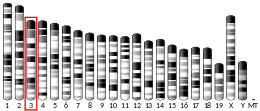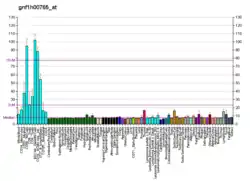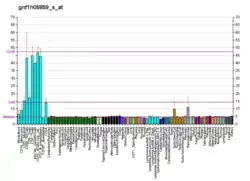| HPS3 | |||||||||||||||||||||||||||||||||||||||||||||||||||
|---|---|---|---|---|---|---|---|---|---|---|---|---|---|---|---|---|---|---|---|---|---|---|---|---|---|---|---|---|---|---|---|---|---|---|---|---|---|---|---|---|---|---|---|---|---|---|---|---|---|---|---|
| Identifiers | |||||||||||||||||||||||||||||||||||||||||||||||||||
| Aliases | HPS3, SUTAL, BLOC2S1, biogenesis of lysosomal organelles complex 2 subunit 1, HPS3 biogenesis of lysosomal organelles complex 2 subunit 1 | ||||||||||||||||||||||||||||||||||||||||||||||||||
| External IDs | OMIM: 606118 MGI: 2153839 HomoloGene: 13019 GeneCards: HPS3 | ||||||||||||||||||||||||||||||||||||||||||||||||||
| |||||||||||||||||||||||||||||||||||||||||||||||||||
| |||||||||||||||||||||||||||||||||||||||||||||||||||
| |||||||||||||||||||||||||||||||||||||||||||||||||||
| |||||||||||||||||||||||||||||||||||||||||||||||||||
| |||||||||||||||||||||||||||||||||||||||||||||||||||
| Wikidata | |||||||||||||||||||||||||||||||||||||||||||||||||||
| |||||||||||||||||||||||||||||||||||||||||||||||||||
Hermansky–Pudlak syndrome 3 protein is a protein that in humans is encoded by the HPS3 gene.[5][6]
This gene encodes a protein containing a potential clathrin-binding motif, consensus dileucine signals, and tyrosine-based sorting signals for targeting to vesicles of lysosomal lineage. The encoded protein may play a role in organelle biogenesis associated with melanosomes, platelet dense granules, and lysosomes. Mutations in this gene are associated with Hermansky–Pudlak syndrome type 3. Alternate splice variants exist, but their full length sequence has not been determined.[6]
References
- 1 2 3 GRCh38: Ensembl release 89: ENSG00000163755 - Ensembl, May 2017
- 1 2 3 GRCm38: Ensembl release 89: ENSMUSG00000027615 - Ensembl, May 2017
- ↑ "Human PubMed Reference:". National Center for Biotechnology Information, U.S. National Library of Medicine.
- ↑ "Mouse PubMed Reference:". National Center for Biotechnology Information, U.S. National Library of Medicine.
- ↑ Anikster Y, Huizing M, White J, Shevchenko YO, Fitzpatrick DL, Touchman JW, Compton JG, Bale SJ, Swank RT, Gahl WA, Toro JR (Jul 2001). "Mutation of a new gene causes a unique form of Hermansky–Pudlak syndrome in a genetic isolate of central Puerto Rico". Nat Genet. 28 (4): 376–80. doi:10.1038/ng576. PMID 11455388. S2CID 418425.
- 1 2 "Entrez Gene: HPS3 Hermansky–Pudlak syndrome 3".
External links
Further reading
- Huizing M, Gahl WA (2003). "Disorders of vesicles of lysosomal lineage: the Hermansky–Pudlak syndromes". Curr. Mol. Med. 2 (5): 451–67. doi:10.2174/1566524023362357. PMID 12125811.
- Oh J, Ho L, Ala-Mello S, et al. (1998). "Mutation analysis of patients with Hermansky–Pudlak syndrome: a frameshift hot spot in the HPS gene and apparent locus heterogeneity". Am. J. Hum. Genet. 62 (3): 593–8. doi:10.1086/301757. PMC 1376951. PMID 9497254.
- Huizing M, Anikster Y, Fitzpatrick DL, et al. (2001). "Hermansky–Pudlak Syndrome Type 3 in Ashkenazi Jews and Other Non–Puerto Rican Patients with Hypopigmentation and Platelet Storage-Pool Deficiency". Am. J. Hum. Genet. 69 (5): 1022–32. doi:10.1086/324168. PMC 1274349. PMID 11590544.
- Suzuki T, Li W, Zhang Q, et al. (2002). "The gene mutated in cocoa mice, carrying a defect of organelle biogenesis, is a homologue of the human Hermansky–Pudlak syndrome-3 gene". Genomics. 78 (1–2): 30–7. doi:10.1006/geno.2001.6644. PMID 11707070.
- Strausberg RL, Feingold EA, Grouse LH, et al. (2003). "Generation and initial analysis of more than 15,000 full-length human and mouse cDNA sequences". Proc. Natl. Acad. Sci. U.S.A. 99 (26): 16899–903. Bibcode:2002PNAS...9916899M. doi:10.1073/pnas.242603899. PMC 139241. PMID 12477932.
- Nazarian R, Falcón-Pérez JM, Dell'Angelica EC (2003). "Biogenesis of lysosome-related organelles complex 3 (BLOC-3): A complex containing the Hermansky–Pudlak syndrome (HPS) proteins HPS1 and HPS4". Proc. Natl. Acad. Sci. U.S.A. 100 (15): 8770–5. Bibcode:2003PNAS..100.8770N. doi:10.1073/pnas.1532040100. PMC 166388. PMID 12847290.
- Ota T, Suzuki Y, Nishikawa T, et al. (2004). "Complete sequencing and characterization of 21,243 full-length human cDNAs". Nat. Genet. 36 (1): 40–5. doi:10.1038/ng1285. PMID 14702039.
- Di Pietro SM, Falcón-Pérez JM, Dell'Angelica EC (2004). "Characterization of BLOC-2, a complex containing the Hermansky–Pudlak syndrome proteins HPS3, HPS5 and HPS6". Traffic. 5 (4): 276–83. doi:10.1111/j.1600-0854.2004.0171.x. PMID 15030569. S2CID 20584286.
- Gerhard DS, Wagner L, Feingold EA, et al. (2004). "The Status, Quality, and Expansion of the NIH Full-Length cDNA Project: The Mammalian Gene Collection (MGC)". Genome Res. 14 (10B): 2121–7. doi:10.1101/gr.2596504. PMC 528928. PMID 15489334.
- Boissy RE, Richmond B, Huizing M, et al. (2005). "Melanocyte-Specific Proteins Are Aberrantly Trafficked in Melanocytes of Hermansky–Pudlak Syndrome-Type 3". Am. J. Pathol. 166 (1): 231–40. doi:10.1016/S0002-9440(10)62247-X. PMC 1602298. PMID 15632015.
- Helip-Wooley A, Westbroek W, Dorward H, et al. (2006). "Association of the Hermansky–Pudlak syndrome type-3 protein with clathrin". BMC Cell Biol. 6: 33. doi:10.1186/1471-2121-6-33. PMC 1249560. PMID 16159387.
- Huizing M, Parkes JM, Helip-Wooley A, et al. (2007). "Platelet alpha granules in BLOC-2 and BLOC-3 subtypes of Hermansky–Pudlak syndrome". Platelets. 18 (2): 150–7. doi:10.1080/13576500600936039. PMID 17365864. S2CID 32161968.
This article is issued from Wikipedia. The text is licensed under Creative Commons - Attribution - Sharealike. Additional terms may apply for the media files.





